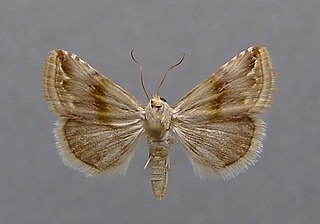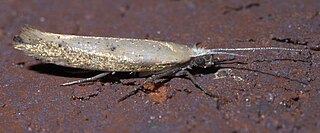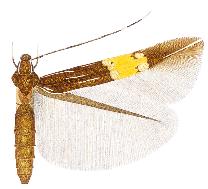
Apamea crenata, known as the clouded-bordered brindle, is a moth in the family Noctuidae. It is distributed throughout the Palearctic realm. In the North it crosses the Arctic Circle, in the Mediterranean it is found only in cool locations and mountains avoiding very hot areas. In the Alps, it rises to an altitude of about 2000 metres.

Cepora nadina, the lesser gull, is a small to medium-sized butterfly of the family Pieridae, that is, the yellows and whites. The species was first described by Hippolyte Lucas in 1852. It is native to Sri Lanka, India, Myanmar, Hainan, and southeast Asia.

The Indian fritillary is a species of butterfly of the nymphalid or brush-footed family. It is usually found from south and southeast Asia to Australia.
Catalexis is a genus of moths in the family Gelechiidae. It contains the species Catalexis tapinota, which is found in Guatemala.

Mesapamea secalis, the common rustic, is a moth of the family Noctuidae. The species was first described by Carl Linnaeus in his 1758 10th edition of Systema Naturae. It is found in Europe, north-west Africa, Turkey and northern Iran.

Grammodes stolida, the geometrician, is a moth of the family Erebidae. The species was first described by Johan Christian Fabricius in 1775. It is found in Africa, southern Europe, most of Asia and Australia. It migrates to central and northern Europe as far north as England, Denmark and Finland.

Nycteola revayana, the oak nycteoline, is a moth of the family Nolidae. The species was first described by Giovanni Antonio Scopoli in 1772. It is found from Europe and east across the Palearctic to Japan and India.

Eublemma ostrina, the purple marbled, is a moth of the family Erebidae. The species was first described by Jacob Hübner in 1808. It is mainly found in central and southern Europe, and further east, but is also a scarce migrant in the United Kingdom, where it is mainly found along the south coast.

Ypsolopha unicipunctella is a moth of the family Ypsolophidae. It is known from the United States, including Oklahoma, Texas and Arizona.
Ypsolopha striatella is a moth of the family Ypsolophidae. It is known from the United States, including California.
Ypsolopha gerdanella is a moth of the family Ypsolophidae. It is known from the United States, including New Mexico.
Ypsolopha delicatella is a moth of the family Ypsolophidae. It is known from the United States, including Arizona and California.
Ypsolopha cockerella is a moth of the family Ypsolophidae. It is known from the United States, including New Mexico.
Ypsolopha querciella is a moth of the family Ypsolophidae. It is known from the United States, including Arizona and Utah.

Cosmopterix astrapias is a moth of the family Cosmopterigidae. It is known from the United States, Argentina, Costa Rica, Jamaica, Mexico (Tabasco) and Puerto Rico.

Cosmopterix callichalca is a moth of the family Cosmopterigidae. It is known from Argentina (Salta), Brazil and the United States

Cosmopterix lespedezae is a moth of the family Cosmopterigidae. It is known from the United States.

Euphaedra eleus, the Eleus orange forester, is a butterfly in the family Nymphalidae. It is found in Guinea, Sierra Leone, Liberia, Ivory Coast, Ghana, Nigeria, Cameroon, Gabon, the Republic of the Congo, Angola, the Democratic Republic of the Congo and Uganda. The habitat consists of primary forests and secondary forests with a closed canopy.
Battaristis cyclella is a moth of the family Gelechiidae. It was described by August Busck in 1903. It is found in North America, where it has been recorded from Arizona and Utah.
Eupragia solida is a moth in the family Depressariidae. It was described by Walsingham in 1911. It is found in Mexico, where it has been recorded from Tabasco.








